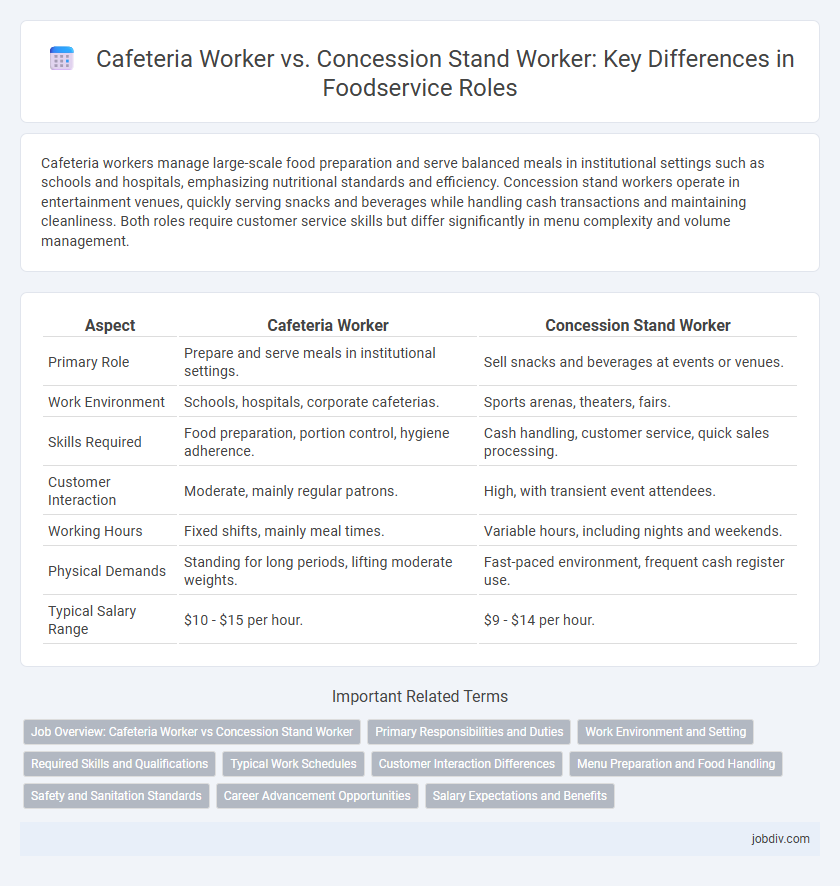Cafeteria workers manage large-scale food preparation and serve balanced meals in institutional settings such as schools and hospitals, emphasizing nutritional standards and efficiency. Concession stand workers operate in entertainment venues, quickly serving snacks and beverages while handling cash transactions and maintaining cleanliness. Both roles require customer service skills but differ significantly in menu complexity and volume management.
Table of Comparison
| Aspect | Cafeteria Worker | Concession Stand Worker |
|---|---|---|
| Primary Role | Prepare and serve meals in institutional settings. | Sell snacks and beverages at events or venues. |
| Work Environment | Schools, hospitals, corporate cafeterias. | Sports arenas, theaters, fairs. |
| Skills Required | Food preparation, portion control, hygiene adherence. | Cash handling, customer service, quick sales processing. |
| Customer Interaction | Moderate, mainly regular patrons. | High, with transient event attendees. |
| Working Hours | Fixed shifts, mainly meal times. | Variable hours, including nights and weekends. |
| Physical Demands | Standing for long periods, lifting moderate weights. | Fast-paced environment, frequent cash register use. |
| Typical Salary Range | $10 - $15 per hour. | $9 - $14 per hour. |
Job Overview: Cafeteria Worker vs Concession Stand Worker
Cafeteria workers manage food preparation, serving, and maintaining cleanliness in institutional dining settings such as schools or hospitals, ensuring food safety and customer satisfaction. Concession stand workers primarily operate portable or temporary food booths, focusing on quick service of snacks and beverages at events or entertainment venues, emphasizing speed and efficiency. Both roles require basic food handling skills but differ in environment and service pace.
Primary Responsibilities and Duties
Cafeteria workers primarily handle food preparation, serving meals, and maintaining cleanliness in institutional settings like schools or hospitals, ensuring compliance with health and safety standards. Concession stand workers focus on selling snacks and beverages at events, managing cash transactions, and restocking inventory while providing quick customer service. Both roles emphasize efficiency and hygiene but differ in environment and specific service tasks.
Work Environment and Setting
Cafeteria workers typically operate in institutional settings such as schools, hospitals, or corporate dining halls, where the environment is structured and designed for high-volume meal service with fixed menus. Concession stand workers often work in dynamic, event-based environments like stadiums, theaters, or fairs, requiring quick service and adaptability to fluctuating customer flow. Both roles demand efficiency but differ significantly in workplace pace and customer interaction style.
Required Skills and Qualifications
Cafeteria workers must possess strong food safety knowledge, efficient multitasking abilities, and excellent customer service skills to handle meal preparation and distribution in fast-paced environments. Concession stand workers require proficiency in operating point-of-sale systems, basic food handling certifications, and the ability to manage inventory and cash transactions accurately. Both roles demand physical stamina, attention to hygiene standards, and effective communication to ensure smooth foodservice operations.
Typical Work Schedules
Cafeteria workers often adhere to regular daytime shifts that align with standard meal hours, typically from early morning to mid-afternoon, accommodating breakfast and lunch service. Concession stand workers generally work flexible and irregular hours, including evenings, weekends, and during special events or sports games, reflecting peak demand times. Both roles require adaptability, but concession stand schedules tend to be more variable and event-driven compared to the structured routine of cafeteria workers.
Customer Interaction Differences
Cafeteria workers engage with a steady flow of customers, often in institutional settings like schools or hospitals, providing personalized service and accommodating dietary needs. Concession stand workers typically experience higher-volume, fast-paced interactions during events, focusing on quick transactions and limited menu options. The level of customer engagement diverges, with cafeteria roles emphasizing consistent, attentive communication and concession roles prioritizing speed and efficiency.
Menu Preparation and Food Handling
Cafeteria workers specialize in preparing diverse menu items following strict nutritional guidelines to accommodate large groups, ensuring food safety through proper storage and cooking techniques. Concession stand workers focus on rapid food preparation of simple, pre-portioned items such as snacks and beverages, emphasizing swift service and maintaining sanitary conditions. Both roles require adherence to food handling regulations, but cafeteria workers often manage complex meal assembly while concession workers prioritize speed and efficiency.
Safety and Sanitation Standards
Cafeteria workers strictly adhere to comprehensive food safety and sanitation standards, including regular hand washing, proper food storage, and sanitizing utensils to prevent cross-contamination in high-volume settings. Concession stand workers follow similar safety protocols but often face challenges due to limited space and faster-paced environments, emphasizing quick clean-up and safe handling of pre-packaged or freshly prepared items. Both roles require compliance with local health regulations to maintain hygiene and protect consumers from foodborne illnesses.
Career Advancement Opportunities
Cafeteria workers often have clearer career advancement opportunities through roles such as kitchen supervisor, food service manager, or nutrition coordinator within institutional settings like schools or hospitals. Concession stand workers typically advance by gaining management responsibilities at larger venues or expanding into event catering and operations coordination. Both roles benefit from skill development in customer service, inventory management, and health regulations, which are critical for progressing into leadership positions.
Salary Expectations and Benefits
Cafeteria workers typically earn a median hourly wage ranging from $11 to $15, often with access to employer-sponsored health insurance and retirement plans in larger institutions. Concession stand workers usually receive lower pay, averaging around $9 to $12 per hour, with fewer comprehensive benefits due to seasonal or part-time positions. Both roles may offer employee discounts on food and flexible scheduling, but cafeteria jobs often provide more stable income and benefit packages.
Cafeteria Worker vs Concession Stand Worker Infographic

 jobdiv.com
jobdiv.com